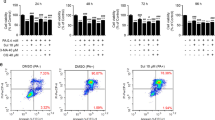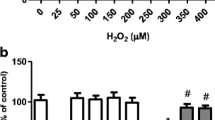Abstract
Eupatilin (5,7-dihydroxy-3,4,6-trimethoxyflavone) has many pharmacological activities including anti-inflammation, anti-oxidant and anti-cancer effects. Autophagy is the basic cellular machinery involving the digestion of damaged cellular components. In the present study, we investigated the protection effects of eupatilin against arachidonic acid (AA) and iron-induced oxidative stress in HepG2 cells and tried to elucidate the molecular mechanisms responsible. Eupatilin increased cell viability against AA + iron in a concentration-dependent manner and prevented mitochondrial dysfunction and reactive oxygen species (ROS) production. In addition, AA + iron increased the levels of pro-apoptotic proteins and these changes were prevented by eupatilin. Eupatilin also induced autophagy, as evidenced by the accumulation of microtubule-associated protein 1 light chain3-II and the detection of autophagic vacuoles. Furthermore, the protective effects of eupatilin on mitochondrial dysfunction and ROS production were significantly abolished by autophagy inhibitors. Eupatilin also increased the mRNA level of sestrin-2 and its promoter-driven reporter gene activity, which resulted in the up-regulation of sestrin-2 protein. Finally, gene silencing using sestrin-2 siRNA and the ectopic expression of recombinant adenoviral sestrin-2 indicated that sestrin-2 induction by eupatilin was required for autophagy-mediated cytoprotection against AA + iron. Our results suggest that eupatilin activates sestrin-2-dependent autophagy, thereby preventing oxidative stress induced by AA + iron.






Similar content being viewed by others
Abbreviations
- 3-MA:
-
3-Methyladenine
- AA:
-
Arachidonic acid
- AMPK:
-
AMP-activated protein kinase
- AO:
-
Acridine orange
- Baf. A1:
-
Bafilomycin A1
- DCF:
-
Dichlorfluorescein
- DCFH-DA:
-
2′,7′-Dichlorofluorescein diacetate
- DMEM:
-
Dulbecco’s modified Eagle’s medium
- FBS:
-
Fetal bovine serum
- GAPDH:
-
Glyceraldehyde-3-phosphate dehydrogenase
- GFP:
-
Green fluorescence protein
- LC3:
-
Microtubule-associated protein 1 light chain 3
- MMP:
-
Mitochondrial membrane potential
- mTOR:
-
Mammalian target of rapamycin
- mTORC1:
-
Mammalian target of rapamycin complex 1
- MTT:
-
3-(4,5-Dimethylthiazol-2-yl)-2,5-diphenyl-tetrazolium bromide
- Nrf2:
-
NF-E2-related factor 2
- p70S6K1:
-
p70 ribosomal S6 protein kinase 1
- PARP:
-
Poly(ADP-ribose)polymerase
- PBS:
-
Phosphate buffered saline
- PI:
-
Propidium iodide
- Rh123:
-
Rhodamine123
- ROS:
-
Reactive oxygen species
- Sesn:
-
Sestrin
- si-Control:
-
siRNA control
- ULK1:
-
Unc-51-like protein kinase1
References
Malhi H, Guicciardi ME, Gores GJ (2010) Hepatocyte death: a clear and present danger. Physiol Rev 90:1165–1194. doi:10.1152/physrev.00061.2009
Balboa MA, Balsinde J (2006) Oxidative stress and arachidonic acid mobilization. Biochim Biophys Acta 1761:385–391. doi:10.1016/j.bbalip.2006.03.014
Scorrano L, Penzo D, Petronilli V et al (2001) Arachidonic acid causes cell death through the mitochondrial permeability transition. Implications for tumor necrosis factor-alpha apoptotic signaling. J Biol Chem 276:12035–12040. doi:10.1074/jbc.M010603200
Cederbaum AI (2003) Iron and CYP2E1-dependent oxidative stress and toxicity. Alcohol 30:115–120. doi:10.1016/S0741-8329(03)00104-6
Choi AMK, Ryter SW, Levine B (2013) Autophagy in human health and disease. N Engl J Med 368:651–662. doi:10.1056/NEJMra1205406
Mortimore GE, Pösö AR, Lardeux BR (1989) Mechanism and regulation of protein degradation in liver. Diabetes Metab Rev 5:49–70. doi:10.1002/dmr.5610050105
Rautou PE, Mansouri A, Lebrec D et al (2010) Autophagy in liver diseases. J Hepatol 53:1123–1134. doi:10.1016/j.jhep.2010.07.006
Kim JS, Nitta T, Mohuczy D et al (2008) Impaired autophagy: a mechanism of mitochondrial dysfunction in anoxic rat hepatocytes. Hepatology 47:1725–1736. doi:10.1002/hep.22187
Sir D, Tian Y, Chen WL et al (2010) The early autophagic pathway is activated by hepatitis B virus and required for viral DNA replication. Proc Natl Acad Sci USA 107:4383–4388. doi:10.1073/pnas.0911373107
Dreux M, Gastaminza P, Wieland SF, Chisari FV (2009) The autophagy machinery is required to initiate hepatitis C virus replication. Proc Natl Acad Sci USA 106:14046–14051. doi:10.1073/pnas.0907344106
Ding ZB, Shi YH, Zhou J et al (2008) Association of autophagy defect with a malignant phenotype and poor prognosis of hepatocellular carcinoma. Cancer Res 68:9167–9175. doi:10.1158/0008-5472.CAN-08-1573
Budanov AV, Shoshani T, Faerman A et al (2002) Identification of a novel stress-responsive gene Hi95 involved in regulation of cell viability. Oncogene 21:6017–6031. doi:10.1038/sj.onc.1205877
Lee JH, Budanov AV, Karin M (2013) Sestrins orchestrate cellular metabolism to attenuate aging. Cell Metab 18:792–801. doi:10.1016/j.cmet.2013.08.018
Budanov AV, Karin M (2008) p53 target genes Sestrin1 and Sestrin2 connect genotoxic stress and mTOR signaling. Cell 134:451–460. doi:10.1016/j.cell.2008.06.028
Parmigiani A, Nourbakhsh A, Ding B et al (2014) Sestrins inhibit mTORC1 kinase activation through the GATOR complex. Cell Rep 9:1281–1291. doi:10.1016/j.celrep.2014.10.019
Maiuri MC, Malik SA, Morselli E et al (2009) Stimulation of autophagy by the p53 target gene Sestrin2. Cell Cycle 8:1571–1576. doi:10.4161/cc.8.10.8498
Shin BY, Jin SH, Cho IJ, Ki SH (2012) Nrf2-ARE pathway regulates induction of Sestrin-2 expression. Free Radic Biol Med 53:834–841. doi:10.1016/j.freeradbiomed.2012.06.026
Yang JH, Kim KM, Kim MG et al (2015) Role of sestrin2 in the regulation of proinflammatory signaling in macrophages. Free Radic Biol Med 78:156–167. doi:10.1016/j.freeradbiomed.2014.11.002
Lee JH, Budanov AV, Talukdar S et al (2012) Maintenance of metabolic homeostasis by Sestrin2 and Sestrin3. Cell Metab 16:311–321. doi:10.1016/j.cmet.2012.08.004
Buitrago-Molina LE, Marhenke S, Longerich T et al (2013) The degree of liver injury determines the role of p21 in liver regeneration and hepatocarcinogenesis in mice. Hepatology 58:1143–1152. doi:10.1002/hep.26412
Cai M, Phan PT, Hong JG et al (2012) The neuroprotective effect of eupatilin against ischemia/reperfusion-induced delayed neuronal damage in mice. Eur J Pharmacol 689:104–110. doi:10.1016/j.ejphar.2012.05.042
Lee S, Lee M, Kim SH (2008) Eupatilin inhibits H2O2-induced apoptotic cell death through inhibition of mitogen-activated protein kinases and nuclear factor-κB. Food Chem Toxicol 46:2865–2870. doi:10.1016/j.fct.2008.05.026
Jeong JH, Moon SJ, Jhun JY et al (2015) Eupatilin exerts antinociceptive and chondroprotective properties in a rat model of osteoarthritis by downregulating oxidative damage and catabolic activity in chondrocytes. PLoS ONE 10:e0130882. doi:10.1371/journal.pone.0130882
Min SW, Kim NJ, Baek NI, Kim DH (2009) Inhibitory effect of eupatilin and jaceosidin isolated from Artemisia princeps on carrageenan-induced inflammation in mice. J Ethnopharmacol 125:497–500. doi:10.1016/j.jep.2009.06.001
Son JE, Lee E, Seo SG et al (2013) Eupatilin, a major flavonoid of Artemisia, attenuates aortic smooth muscle cell proliferation and migration by inhibiting PI3K, MKK3/6, and MKK4 activities. Planta Med 79:1009–1016. doi:10.1055/s-0033-1350621
Cheong JH, Hong SY, Zheng Y, Noh SH (2011) Eupatilin inhibits gastric cancer cell growth by blocking STAT3-mediated VEGF expression. J Gastric Cancer 11:16–22. doi:10.5230/jgc.2011.11.1.16
Seol SY, Kim MH, Ryu JS et al (2004) DA-9601 for erosive gastritis: results of a double-blind placebo-controlled phase III clinical trial. World J Gastroenterol 10:2379. doi:10.3748/wjg.v10.i16.2379
Ryu BK, Ahn BO, Oh TY et al (1998) Studies on protective effect of DA-9601, Artemisia asiatica extract, on acetaminophen- and CCl4-induced liver damage in rats. Arch Pharm Res 21:508–513. doi:10.1007/BF02975366
Cheong JY, Oh TY, Lee KM et al (2002) Suppressive effects of antioxidant DA-9601 on hepatic fibrosis in rats. Taehan Kan Hakhoe chi 8:436–447
Park SC, Yoon JH, Kim W et al (2006) Eupatilin attenuates bile acid-induced hepatocyte apoptosis. J Gastroenterol 41:772–778. doi:10.1007/s00535-006-1854-6
Shin SM, Kim SG (2009) Inhibition of arachidonic acid and iron-induced mitochondrial dysfunction and apoptosis by oltipraz and novel 1,2-dithiole-3-thione congeners. Mol Pharmacol 75:242–253. doi:10.1124/mol.108.051128
Wang K, Liu R, Li J et al (2011) Quercetin induces protective autophagy in gastric cancer cells: involvement of Akt-mTOR- and hypoxia-induced factor 1α-mediated signaling. Autophagy 7:966–978. doi:10.4161/auto.7.9.15863
Nah J, Pyo JO, Jung S et al (2013) BECN1/Beclin 1 is recruited into lipid rafts by prion to activate autophagy in response to amyloid β 42. Autophagy 9:2009–2021. doi:10.4161/auto.26118
Dong GZ, Jang EJ, Kang SH et al (2013) Red ginseng abrogates oxidative stress via mitochondria protection mediated by LKB1-AMPK pathway. BMC Complement Altern Med 13:64. doi:10.1186/1472-6882-13-64
Klionsky DJ, Abdalla FC, Abeliovich H et al (2012) Guidelines for the use and interpretation of assays for monitoring autophagy. Autophagy 8:445–544. doi:10.4161/auto.19496
Yamamoto A, Tagawa Y, Yoshimori T et al (1998) Bafilomycin A1 prevents maturation of autophagic vacuoles by inhibiting fusion between autophagosomes and lysosomes in rat hepatoma cell line, H-4-II-E cells. Cell Struct Funct 23:33–42. doi:10.1247/csf.23.33
Ishihara M, Urushido M, Hamada K et al (2013) Sestrin-2 and BNIP3 regulate autophagy and mitophagy in renal tubular cells in acute kidney injury. Am J Physiol Renal Physiol 305:F495–F509. doi:10.1152/ajprenal.00642.2012
Seo K, Ki SH, Shin SM (2015) Sestrin2-AMPK activation protects mitochondrial function against glucose deprivation-induced cytotoxicity. Cell Signal 27:1533–1543. doi:10.1016/j.cellsig.2015.03.003
Gottlieb RA, Carreira RS (2010) Autophagy in health and disease. 5. Mitophagy as a way of life. Am J Physiol Cell Physiol 299:C203–C210. doi:10.1152/ajpcell.00097.2010
Bhogal RH, Weston CJ, Curbishley SM et al (2012) Autophagy: a cyto-protective mechanism which prevents primary human hepatocyte apoptosis during oxidative stress. Autophagy 8:545–558. doi:10.4161/auto.19012
Pankiv S, Clausen TH, Lamark T et al (2007) p62/SQSTM1 binds directly to Atg8/LC3 to facilitate degradation of ubiquitinated protein aggregates by autophagy. J Biol Chem 282:24131–24145. doi:10.1074/jbc.M702824200
Wu D, Cederbaum AI (2013) Inhibition of autophagy promotes CYP2E1-dependent toxicity in HepG2 cells via elevated oxidative stress, mitochondria dysfunction and activation of p38 and JNK MAPK. Redox Biol 1:552–565. doi:10.1016/j.redox.2013.10.008
Brüning A, Rahmeh M, Friese K (2013) Nelfinavir and bortezomib inhibit mTOR activity via ATF4-mediated sestrin-2 regulation. Mol Oncol 7:1012–1018. doi:10.1016/j.molonc.2013.07.010
Bae SH, Sung SH, Oh SY et al (2013) Sestrins activate Nrf2 by promoting p62-dependent autophagic degradation of Keap1 and prevent oxidative liver damage. Cell Metab 17:73–84. doi:10.1016/j.cmet.2012.12.002
Song HJ, Shin CY, Oh TY et al (2009) Eupatilin with heme oxygenase-1-inducing ability protects cultured feline esophageal epithelial cells from cell damage caused by indomethacin. Biol Pharm Bull 32:589–596. doi:10.1248/bpb.32.589
Jin SH, Yang JH, Shin BY et al (2013) Resveratrol inhibits LXRα-dependent hepatic lipogenesis through novel antioxidant Sestrin2 gene induction. Toxicol Appl Pharmacol 271:95–105. doi:10.1016/j.taap.2013.04.023
Egan DF, Shackelford DB, Mihaylova MM et al (2011) Phosphorylation of ULK1 (hATG1) by AMP-activated protein kinase connects energy sensing to mitophagy. Science 331:456–461. doi:10.1126/science.1196371
Ro SH, Semple IA, Park H et al (2014) Sestrin2 promotes Unc-51-like kinase 1 mediated phosphorylation of p62/sequestosome-1. FEBS J 281:3816–3827. doi:10.1111/febs.12905
Zoncu R, Efeyan A, Sabatini DM (2011) mTOR: from growth signal integration to cancer, diabetes and ageing. Nat Rev Mol Cell Biol 12:21–35. doi:10.1038/nrm3025
Tee AR, Proud CG (2000) DNA-damaging agents cause inactivation of translational regulators linked to mTOR signalling. Oncogene 19:3021–3031. doi:10.1038/sj.onc.1203622
Dhar R, Persaud SD, Mireles JR, Basu A (2009) Proteolytic cleavage of p70 ribosomal S6 kinase by caspase-3 during DNA damage-induced apoptosis. Biochemistry 48:1474–1480. doi:10.1021/bi801840s
Acknowledgments
This work was supported by the National Research Foundation of Korea (NRF) grant funded by the Korea government [MSIP] (No. 2012R1A5A2A42671316). K. H. Jegal would like to thank the degree program of Master at Daegu Haany University for completing the thesis through this work. The authors express thanks to Mr. Seung Wook Yi (Shin Woo Tech, Daegu, Korea) for the technical assistance of fluorescence microscope analysis.
Author information
Authors and Affiliations
Corresponding authors
Ethics declarations
Conflict of interest
The authors declare that they have no conflict of interest.
Electronic supplementary material
Below is the link to the electronic supplementary material.
Rights and permissions
About this article
Cite this article
Jegal, K.H., Ko, H.L., Park, S.M. et al. Eupatilin induces Sestrin2-dependent autophagy to prevent oxidative stress. Apoptosis 21, 642–656 (2016). https://doi.org/10.1007/s10495-016-1233-6
Published:
Issue Date:
DOI: https://doi.org/10.1007/s10495-016-1233-6




